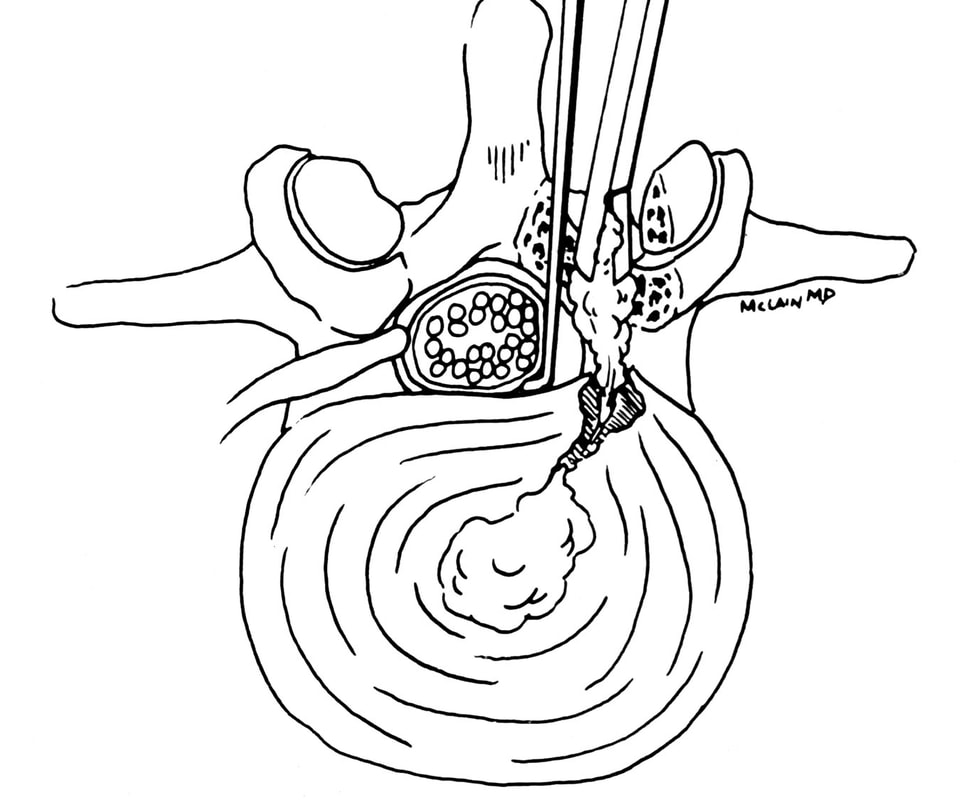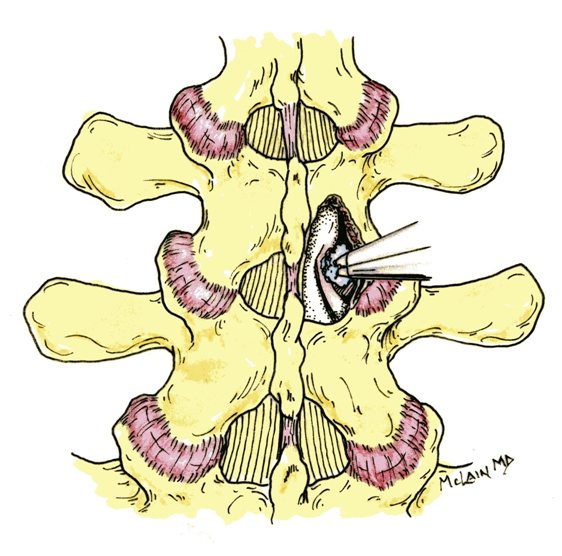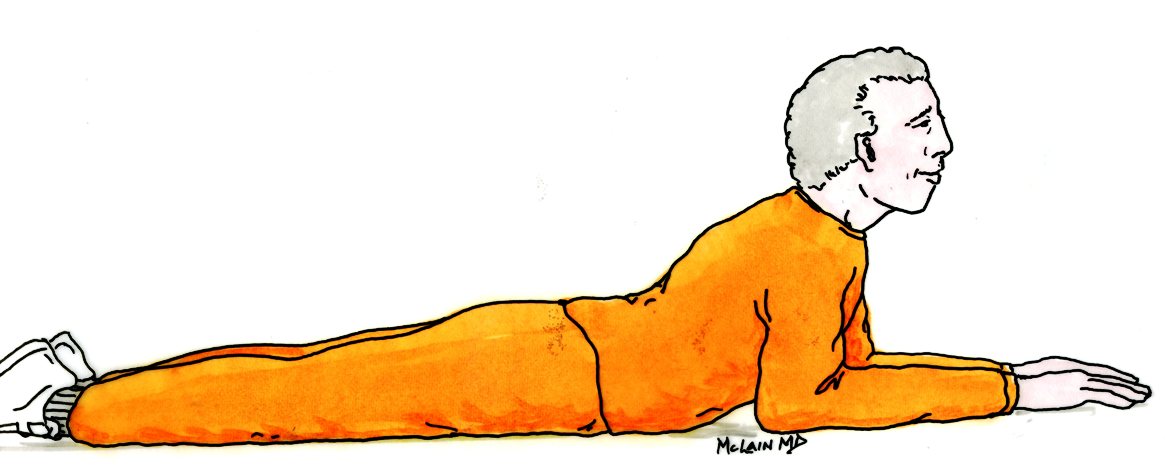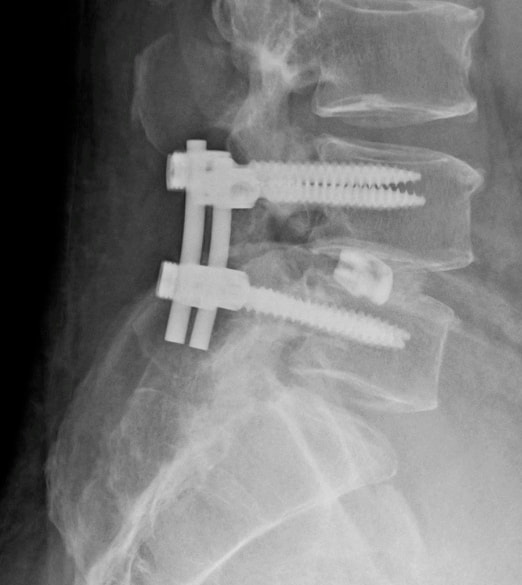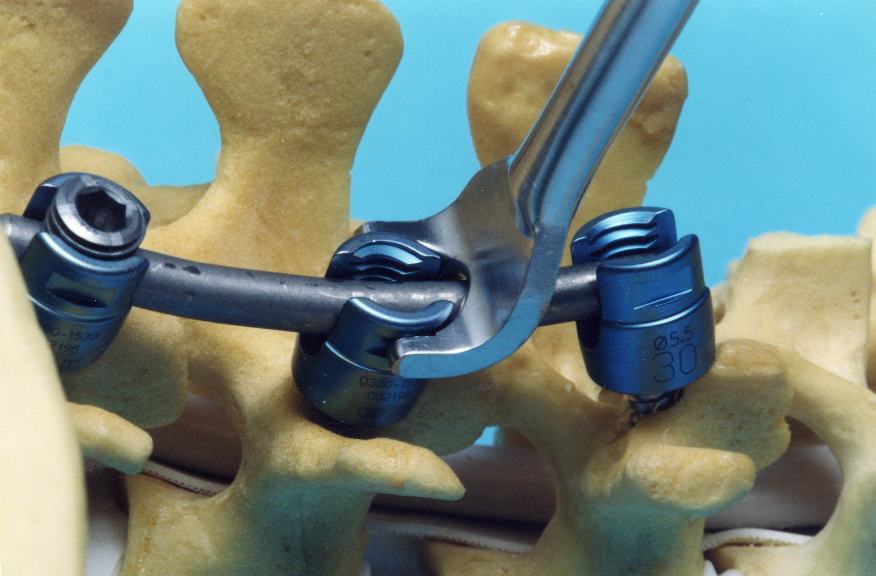Post-operative Instructions for Dr. McLain's Patients: Part 2: The Lumbar Spine
What to do after Lumbar Spine Surgery
If you read Part 1, you know the general principles I'm going to get to here, but you may still be wondering what to do to take care of your wound in the first weeks after lumbar spine surgery.
The most common source of confusion after lumbar surgery revolves around what kind of surgery a patient may have had. And, in this case, any confusion is usually the result of confusing spinal decompression surgery - microdiscectomy or laminectomy - with spinal fusion surgery.
So here's what you need to know about post-operative care following lumbar surgery:
Wound Care After Lower Back (Lumbar) Surgery - For All Patients:
The sterile dressing applied in the Operating Room needs to be left in place for four to six days. If there is a little blood on the dressing do not worry about it, but if the dressing becomes soaked or loose, it can be reinforced with a bulky cover dressing until it can be peeled away with clean hands and a new gauze pad placed over the surface dressing. Tape this back in place and keep it clean.
So here's what you need to know about post-operative care following lumbar surgery:
Wound Care After Lower Back (Lumbar) Surgery - For All Patients:
The sterile dressing applied in the Operating Room needs to be left in place for four to six days. If there is a little blood on the dressing do not worry about it, but if the dressing becomes soaked or loose, it can be reinforced with a bulky cover dressing until it can be peeled away with clean hands and a new gauze pad placed over the surface dressing. Tape this back in place and keep it clean.
Do not get the dressing wet. You may shower after three days, but cover the dressing with saran and tape and avoid directly soaking it. DO NOT take a tub bath or submerge the wound in water until fully healed and sealed - 10 - 12 days.
After 4-6 days, you may remove the outer dressing and cover the inner dressing with gauze for comfort or leave open to air.
If you find a piece of suture protruding from the skin don't fiddle with it. The surgical closure for my lumbar wounds, just as with my cervical incisions, is a plastic surgery closure with stitches that are absorbable. The small knot tied on the skin will blow away after the stitches have resorbed.
If the wound is sore, you may place a bit of ice in a bag (a bag of frozen peas works great) for a bit to reduce swelling and pain. Do not put ice directly on your skin.
At ten to twelve days the wound should be completely sealed and you can peel away or wash away any remaining dressing over the wound, or you can leave it to peel away on its own.
Slight bleeding from the wound may persist for 3 -5 days after surgery, but should then stop. Continued drainage, drainage that starts up again after the wound appeared to seal, or swelling redness, or increasing pain at the incision site are all things I want to hear about, so please call the office early in the day before things become severe, or go to your emergency room for an examination.
After 4-6 days, you may remove the outer dressing and cover the inner dressing with gauze for comfort or leave open to air.
If you find a piece of suture protruding from the skin don't fiddle with it. The surgical closure for my lumbar wounds, just as with my cervical incisions, is a plastic surgery closure with stitches that are absorbable. The small knot tied on the skin will blow away after the stitches have resorbed.
If the wound is sore, you may place a bit of ice in a bag (a bag of frozen peas works great) for a bit to reduce swelling and pain. Do not put ice directly on your skin.
At ten to twelve days the wound should be completely sealed and you can peel away or wash away any remaining dressing over the wound, or you can leave it to peel away on its own.
Slight bleeding from the wound may persist for 3 -5 days after surgery, but should then stop. Continued drainage, drainage that starts up again after the wound appeared to seal, or swelling redness, or increasing pain at the incision site are all things I want to hear about, so please call the office early in the day before things become severe, or go to your emergency room for an examination.
For Lumbar Discectomy and Laminectomy Patients:
If you've had a discectomy, Microdiscectomy or laminectomy, without a fusion(this means the surgeon felt your spine was stable and back pain wasn't the biggest issue) follow these instructions.
Care and activity after a lumbar decompression surgery is VERY DIFFERENT from care after a lumbar fusion! I discuss these four points with every single patient I operate on.
Post-Operative Care for Lumbar Discectomy/Laminectomy Patients:
The first one-two weeks after surgery are about getting over the incisional pain. Lumbar incisions traumatize a lot of muscle and muscular/incisional pain can be severe and can persist for weeks.
Patients should limit bending, lifting, and twisting activity during the first two weeks to avoid aggravating the healing wound and causing pain at the surgical site. Standing, walking, and careful bending will not cause any injury or damage, but over-activity may aggravate incisional pain. If that happens, the patient should back off, rest a bit, and ice the site before they get going again.
Back Brace: A corset is provided after lumbar disc surgery to wear while the incision is healing, but only for the first few weeks until muscle pain is under control. It is not used at night, when eating, or during light daily activities – gentle frequent motion is desirable. And after 3-4 weeks, we will want to have you take it off and start working on strengthening your back muscles!
If you've had a discectomy, Microdiscectomy or laminectomy, without a fusion(this means the surgeon felt your spine was stable and back pain wasn't the biggest issue) follow these instructions.
Care and activity after a lumbar decompression surgery is VERY DIFFERENT from care after a lumbar fusion! I discuss these four points with every single patient I operate on.
- After surgery, fusion patients do need to avoid back motion, and limit bending, lifting and twisting for several weeks, but the discectomy patient does not need to limit motion for as long or as completely, and they should start gentle range of motion as soon as they are comfortable (3-5 days).
- After surgery, fusion patients may need to wear a rigid brace, full time, for several weeks, but the discectomy or laminectomy patient usually needs no brace, or may wear a soft corset for only three weeks before starting light activities.
- After surgery, fusion patients need to avoid anti-inflammatory medications (NSAIDs) for eight to twelve weeks, but the discectomy or laminectomy patient can take NSAIDs, and they can start using NSAIDs (Advil, Aleve, Ibuprofen, Naprosyn, etc) to treat back and muscular pain after the first week following surgery.
- And finally - if fusion patients overdo it after surgery or don't follow instructions they can harm themselves, seriously affect their result, and end up needing more surgery. If discectomy or laminectomy patients overdo it, get active too soon, or don't follow advice, they tend to make themselves sore, but they won't harm themselves or damage the spine unless they persist despite pain and against advice, in activities that subject them to heavy loads or repetitive bending and twisting.
Post-Operative Care for Lumbar Discectomy/Laminectomy Patients:
The first one-two weeks after surgery are about getting over the incisional pain. Lumbar incisions traumatize a lot of muscle and muscular/incisional pain can be severe and can persist for weeks.
Patients should limit bending, lifting, and twisting activity during the first two weeks to avoid aggravating the healing wound and causing pain at the surgical site. Standing, walking, and careful bending will not cause any injury or damage, but over-activity may aggravate incisional pain. If that happens, the patient should back off, rest a bit, and ice the site before they get going again.
Back Brace: A corset is provided after lumbar disc surgery to wear while the incision is healing, but only for the first few weeks until muscle pain is under control. It is not used at night, when eating, or during light daily activities – gentle frequent motion is desirable. And after 3-4 weeks, we will want to have you take it off and start working on strengthening your back muscles!
Activities:
After discharge from the hospital - right from the start:
Every day, get up and walk three to four times every day– Walk briskly, fifteen to thirty minutes without stopping to sit down – indoors or out, as tolerated. Bend carefully, but bend to put on your own slippers or shoes. Limit lifting, but feel safe lifting and carrying 5 – 10lbs as needed.
After 7 - 10 days:
Increase daily walking, and start back to regular exercise on treadmill or exercise bike. Start gentle range of motion exercise – flexion/extension and side bending – within the range of pain-free motion.
Increase normal bending and gentle twisting during light activities at home.
When back motion is comfortable and you are no longer taking pain medications, you may start driving short distances. You may increase lifting and carrying up to 10 – 15 lbs as comfortable.
Add activities a little at a time, and don’t overdo it. Change positions every half-hour. When you go back to a common activity, do a bit for 15 minutes then stop, rest, and reassess: If you're starting to stiffen up, knock off for the day. If you feel good, you can take on more.
At three weeks:
Return to Dr. McLain’s Clinic for your post-operative x-rays and check-up. Start light daily activities without restrictions. Increase walking and exercise activities, and increase bending and lifting as tolerated for light activities in the house.
Aerobic activity as tolerated – may start running if you like, increase cycling, or add a pool program.
At six weeks:
Return to Dr. McLain’s Clinic for your post-operative check-up. If all is well, we’ll start home or formal Physical Therapy for the lower back and core strengthening, flexibility, and conditioning.
Recommended Physical Therapy Exercises After Week Four to Six for Cervical Total Disc Replacement Patients:
Daily activity, and a regular aerobic exercise program, are the keys to getting most people back to good function, and are important in all neck and back surgery patients. Time invested in a physical therapy and exercise program is never wasted.
For Lumbar FUSION Patients:
After discharge from the hospital - right from the start:
Every day, get up and walk three to four times every day– Walk briskly, fifteen to thirty minutes without stopping to sit down – indoors or out, as tolerated. Bend carefully, but bend to put on your own slippers or shoes. Limit lifting, but feel safe lifting and carrying 5 – 10lbs as needed.
After 7 - 10 days:
Increase daily walking, and start back to regular exercise on treadmill or exercise bike. Start gentle range of motion exercise – flexion/extension and side bending – within the range of pain-free motion.
Increase normal bending and gentle twisting during light activities at home.
When back motion is comfortable and you are no longer taking pain medications, you may start driving short distances. You may increase lifting and carrying up to 10 – 15 lbs as comfortable.
Add activities a little at a time, and don’t overdo it. Change positions every half-hour. When you go back to a common activity, do a bit for 15 minutes then stop, rest, and reassess: If you're starting to stiffen up, knock off for the day. If you feel good, you can take on more.
At three weeks:
Return to Dr. McLain’s Clinic for your post-operative x-rays and check-up. Start light daily activities without restrictions. Increase walking and exercise activities, and increase bending and lifting as tolerated for light activities in the house.
Aerobic activity as tolerated – may start running if you like, increase cycling, or add a pool program.
At six weeks:
Return to Dr. McLain’s Clinic for your post-operative check-up. If all is well, we’ll start home or formal Physical Therapy for the lower back and core strengthening, flexibility, and conditioning.
Recommended Physical Therapy Exercises After Week Four to Six for Cervical Total Disc Replacement Patients:
Daily activity, and a regular aerobic exercise program, are the keys to getting most people back to good function, and are important in all neck and back surgery patients. Time invested in a physical therapy and exercise program is never wasted.
For Lumbar FUSION Patients:
If you've had a Lumbar Fusion, (most often a Posterior Decompression and Fusion or TLIF) follow these instructions:
Post-Operative Care for Lumbar Fusion Patients:
The first one-two weeks after any surgery are dedicated to getting over the post-operative pain. Patients should limit activity to avoid aggravating the healing wound and causing pain at the surgical site, and to avoid stressing the fusion before it has had a chance to get started.
Standing, walking, and careful bending will not cause any injury or damage, but over-activity may aggravate incisional pain or slow or disrupt the early fusion, which can lead to a surgical failure. Patients can safely bend to put their socks and shoes on, but must avoid repetitive bending, lifting, and twisting.
Activities:
After discharge from the hospital - right from the start:
Every day, get up and walk three to four times every day– Walk briskly, fifteen to thirty minutes without stopping to sit down – indoors or out, as tolerated. Bend carefully, but bend to put on your own slippers or shoes. Limit lifting, but feel safe lifting and carrying 10 – 15lbs as needed.
After 7 - 10 days:
Increase daily walking, and start back to light exercise on treadmill or exercise bike. Do not start trying back exercises or back range of motion exercises yet.
Increase normal bending and twisting of the lower back during light activities at home.
- After surgery, fusion patients do need to avoid back motion for several weeks, and cannot start back range of motion until the fusion has had a chance to get started (4-6 weeks).
- After surgery, fusion patients may need to wear a rigid back brace, full time, for several weeks, and should take it off only to bathe, and later when they sleep.
- After surgery, fusion patients need to avoid anti-inflammatory medications (NSAIDs) for eight to twelve weeks, as these medications (Advil, Aleve, Ibuprofen, Naprosyn, etc) can interfere with the fusion.
- And finally - if fusion patients overdo it after surgery or don't follow instructions they can harm themselves, seriously affect their result, and end up needing more surgery. Pushing forward too fast, cheating on brace-wear or restrictions, or cigarette smoking increases the risk of a non-union (pseudarthrosis) or can even cause the fixation implants to loosen or break. That would mean more surgery.
Post-Operative Care for Lumbar Fusion Patients:
The first one-two weeks after any surgery are dedicated to getting over the post-operative pain. Patients should limit activity to avoid aggravating the healing wound and causing pain at the surgical site, and to avoid stressing the fusion before it has had a chance to get started.
Standing, walking, and careful bending will not cause any injury or damage, but over-activity may aggravate incisional pain or slow or disrupt the early fusion, which can lead to a surgical failure. Patients can safely bend to put their socks and shoes on, but must avoid repetitive bending, lifting, and twisting.
Activities:
After discharge from the hospital - right from the start:
Every day, get up and walk three to four times every day– Walk briskly, fifteen to thirty minutes without stopping to sit down – indoors or out, as tolerated. Bend carefully, but bend to put on your own slippers or shoes. Limit lifting, but feel safe lifting and carrying 10 – 15lbs as needed.
After 7 - 10 days:
Increase daily walking, and start back to light exercise on treadmill or exercise bike. Do not start trying back exercises or back range of motion exercises yet.
Increase normal bending and twisting of the lower back during light activities at home.
At three weeks:
Return to Dr. McLain’s Clinic for your post-operative x-rays and check-up. Start light daily activities with restrictions. Increase walking and exercise activities, and increase bending and lifting as tolerated for light activities in the house. Continue wearing your collar as instructed. Patients with a desk or phone job can work from home or be driven to work for light duty as tolerated.
Aerobic activity as tolerated – may start treadmill or elliptical exercise if you like, increase stationary cycling, but cannot add a pool program that involves swimming until fusion is solid and range of motion is restored.
At six weeks:
Return to Dr. McLain’s Clinic for your post-operative check-up and more x-rays. If all is well, we’ll start weaning you out of the back brace and plan to start a formal Physical Therapy Program for back and core strengthening, flexibility, and conditioning for week eight to ten.
Recommended Physical Therapy Exercises After Week Eight to Ten for Cervical Fusion Patients:
Daily activity, and a regular aerobic exercise program, are the keys to getting most people back to good function, whether they've had a disc removal, a lumbar fusion, or treatment for a fracture or other disorder.
Return to Dr. McLain’s Clinic for your post-operative x-rays and check-up. Start light daily activities with restrictions. Increase walking and exercise activities, and increase bending and lifting as tolerated for light activities in the house. Continue wearing your collar as instructed. Patients with a desk or phone job can work from home or be driven to work for light duty as tolerated.
Aerobic activity as tolerated – may start treadmill or elliptical exercise if you like, increase stationary cycling, but cannot add a pool program that involves swimming until fusion is solid and range of motion is restored.
At six weeks:
Return to Dr. McLain’s Clinic for your post-operative check-up and more x-rays. If all is well, we’ll start weaning you out of the back brace and plan to start a formal Physical Therapy Program for back and core strengthening, flexibility, and conditioning for week eight to ten.
Recommended Physical Therapy Exercises After Week Eight to Ten for Cervical Fusion Patients:
Daily activity, and a regular aerobic exercise program, are the keys to getting most people back to good function, whether they've had a disc removal, a lumbar fusion, or treatment for a fracture or other disorder.
